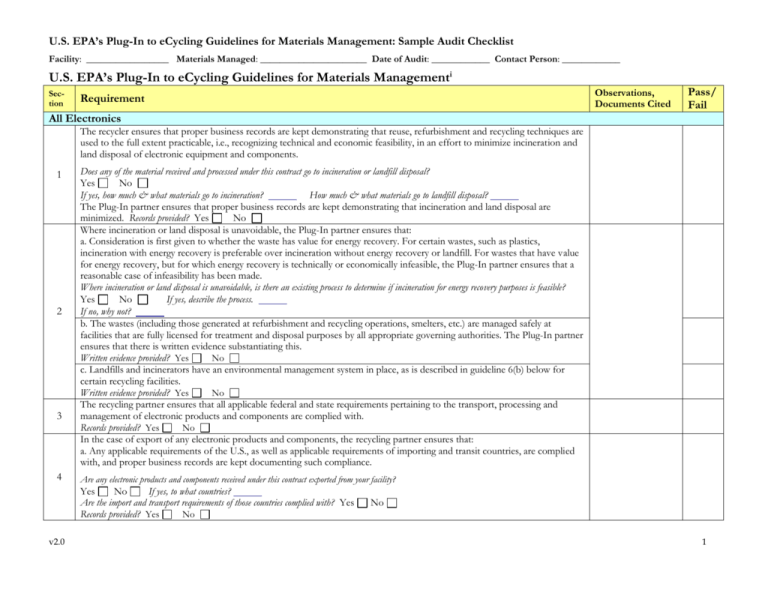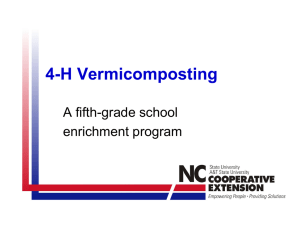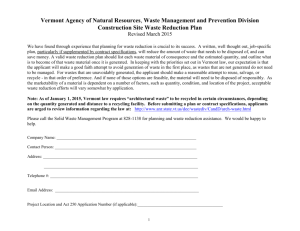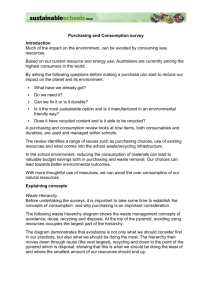U.S. EPA`s Plug-In to eCycling Guidelines for Materials
advertisement

U.S. EPA’s Plug-In to eCycling Guidelines for Materials Management: Sample Audit Checklist Facility: _________________ Materials Managed: ______________________ Date of Audit: ____________ Contact Person: ____________ U.S. EPA’s Plug-In to eCycling Guidelines for Materials Managementi Section Observations, Documents Cited Requirement Pass/ Fail All Electronics The recycler ensures that proper business records are kept demonstrating that reuse, refurbishment and recycling techniques are used to the full extent practicable, i.e., recognizing technical and economic feasibility, in an effort to minimize incineration and land disposal of electronic equipment and components. 1 2 3 4 Does any of the material received and processed under this contract go to incineration or landfill disposal? Yes No If yes, how much & what materials go to incineration? How much & what materials go to landfill disposal? The Plug-In partner ensures that proper business records are kept demonstrating that incineration and land disposal are minimized. Records provided? Yes No Where incineration or land disposal is unavoidable, the Plug-In partner ensures that: a. Consideration is first given to whether the waste has value for energy recovery. For certain wastes, such as plastics, incineration with energy recovery is preferable over incineration without energy recovery or landfill. For wastes that have value for energy recovery, but for which energy recovery is technically or economically infeasible, the Plug-In partner ensures that a reasonable case of infeasibility has been made. Where incineration or land disposal is unavoidable, is there an existing process to determine if incineration for energy recovery purposes is feasible? Yes No If yes, describe the process. If no, why not? b. The wastes (including those generated at refurbishment and recycling operations, smelters, etc.) are managed safely at facilities that are fully licensed for treatment and disposal purposes by all appropriate governing authorities. The Plug-In partner ensures that there is written evidence substantiating this. Written evidence provided? Yes No c. Landfills and incinerators have an environmental management system in place, as is described in guideline 6(b) below for certain recycling facilities. Written evidence provided? Yes No The recycling partner ensures that all applicable federal and state requirements pertaining to the transport, processing and management of electronic products and components are complied with. Records provided? Yes No In the case of export of any electronic products and components, the recycling partner ensures that: a. Any applicable requirements of the U.S., as well as applicable requirements of importing and transit countries, are complied with, and proper business records are kept documenting such compliance. Are any electronic products and components received under this contract exported from your facility? Yes No If yes, to what countries? Are the import and transport requirements of those countries complied with? Yes Records provided? Yes No v2.0 No 1 U.S. EPA’s Plug-In to eCycling Guidelines for Materials Management: Sample Audit Checklist Facility: _________________ Materials Managed: ______________________ Date of Audit: ____________ Contact Person: ____________ Section Observations, Documents Cited Requirement Pass/ Fail b. Prior to export, the materials listed below are removed and handled separately, unless: i. The export is for purposes of reuse or refurbishment, or ii. The Plug-In partner has documented and regularly monitored controls in place to assure that the materials will be removed in member countries of the OECD: (1) Batteries. (2) Mercury- and PCB-containing lamps and devices. (3) Circuit boards, unless they are contained in hand-held electronic equipment, such as cellular phones, PDAs, etc. (Note: Under U.S. rules, minimal quantities of mercury and batteries that are protectively packaged to minimize dispersion of metal constituents do not need to be removed from whole circuit boards). (4) CRTs and CRT glass, both of which are adequately processed for use as an industrial feedstock material prior to export. If the export is not for the purposes of reuse or refurbishment, are batteries, mercury- and PCB-containing lamps and devices, circuit boards and CRTs/CRT glass removed and handled separately before exporting to member countries of the OECD (Organization for Economic Co-operation and Development)? Yes No If no, why not? Records showing documented & regularly monitored controls to assure materials are removed in OECD countries provided? Yes No If no, why not? “Designated materials” for reuse or refurbishment This guideline applies to designated materials that are directed to reuse or refurbishment. However, it is only intended to apply to those shipments of designated materials (such as the following intact equipment: monitors, televisions, CRT bulbs, CPUs, laptops, printers and cell phones) that have been prescreened to meet legitimate reuse or refurbishment specifications. Unscreened shipments for evaluation of reuse/refurbishment potential and shipments containing some reusable (or refurbishable) and some non-reusable (or non-refurbishable) equipment are considered shipments for recycling and are addressed in guideline 6. In the case of refurbishment, guidelines 1-4 and 6 apply to any components that are subsequently determined to be unusable. For designated materials that are directed to reuse or refurbishment, the Plug-In partner ensures that: 5 a. All items in the shipment meet legitimate reuse or refurbishment specifications. List the items containing batteries, mercury- and PCB-containing lamps and devices, circuit boards and CRTs/CRT glass that have been pre-screened and meet legitimate reuse or refurbishment requirements. b. All items in the shipment meet the specifications of the consignee. Do all items in each shipment meet legitimate reuse or refurbishment specifications? Yes No If no, why not? c. All items in the shipment are packaged in a manner that is consistent with preservation of the used equipment for reuse or refurbishment. That is, the packaging protects the used equipment in storage and transport, such that the value of the used equipment for reuse or refurbishment is not diminished. Are all items in each shipment packaged in a manner that is consistent with preservation of the equipment? Yes If no, why not? List all downstream facilities that receive designated materials from this subscriber, from this facility. v2.0 No 2 U.S. EPA’s Plug-In to eCycling Guidelines for Materials Management: Sample Audit Checklist Facility: _________________ Materials Managed: ______________________ Date of Audit: ____________ Contact Person: ____________ Section Observations, Documents Cited Requirement Pass/ Fail d. Proper business records are kept that document the transfer of the used equipment to the consignee for reuse or refurbishment purposes, including: i. Name and address of consignee. ii. Description of shipment content and conformance with consignee product specifications. iii. Product specifications of consignee. iv. If for-profit transaction, amount paid for the consigned material. Records provided? Yes No “Designated materials” for recycling The recycling partner ensures that all designated materials that are directed to recycling are processed by facilities that meet the guidelines herein. The recycling partner ensures that proper business records are kept that demonstrate that all downstream processing and recycling operations, including smelters, that receive designated materials, use practices that are consistent with these guidelines. For any processing and recycling facilities that receive designated materials, the recycling partner ensures that: a. Facilities are fully licensed by all appropriate governing authorities. The degree of licensing necessary will vary depending upon the particular jurisdiction, as well as the size and nature of the facility. In some cases, extensive environmental permitting may be required by the governmental authorities, whereas in other cases perhaps only a business license is needed. Are all of the downstream facilities receiving designated materials in possessions of current, appropriate licenses and permits, to receive and handle these materials? Review environmental, land use, business, etc. Yes No 6 Records and copies of permits provided? Yes No If no, why not? b. Facilities have an environmental management system (EMS) in place. EPA recognizes that flexibility for small businesses is necessary and that, in some cases, a fully developed and certified EMS may be unnecessary. In lieu of a fully developed and certified EMS (e.g., using ISO, EMAS or industry standards, such as those of the IAER), a facility has a written plan describing the facility’s risk management objectives for environmental performance and compliance and its plans for attaining these objectives based on a “plan-do-check-act” continual improvement model. Regular re-evaluation of environment, health and safety (EH&S) objectives and monitoring of progress toward achievement of these objectives is conducted and documented at all facilities. EPA also recognizes that a fully developed EMS may not yet be in place for many facilities. In any case, a written plan describing risk management objectives and plans for attainment based on a “plan-do-check-act” model is in place. Do all of the downstream operations that receive designated materials from this facility have an EMS in place? Yes No Records and copies of permits provided? Yes If no, why not? v2.0 No 3 U.S. EPA’s Plug-In to eCycling Guidelines for Materials Management: Sample Audit Checklist Facility: _________________ Materials Managed: ______________________ Date of Audit: ____________ Contact Person: ____________ Section Observations, Documents Cited Requirement Pass/ Fail c. Facilities take sufficient measures to safeguard occupational and environmental health and safety. Such measures may be indicated by local, state, national and international regulations, agreements, principles and standards, as well as by industry standards and guidelines. Except as noted below, such measures for all facilities include: i. EH&S training of personnel. ii. An up-to-date, written hazardous materials identification and management plan that specifically addresses at least the following: lead, mercury, beryllium, cadmium, batteries, toner, phosphor compounds, PCBs, and brominated flame retardants and other halogenated materials, with particular focus on possible generation of by-product dioxins and furans. iii. Where materials are shredded or heated, appropriate measures to protect workers, the general public and the environment from hazardous dusts and emissions. Such measures include adaptations in equipment design or operational practices, air flow controls, personal protective devices for workers, pollution control equipment or a combination of these measures. iv. An up-to-date, written plan for reporting and responding to exceptional pollutant releases, including emergencies such as accidents, spills, fires, and explosions. v. Liability insurance for pollutant releases, accidents and other emergencies. vi. Completion of an EH&S audit, preferably by a recognized independent auditor, on an annual basis. However, for small businesses, greater flexibility may be needed, and an audit every three years may be appropriate. Do all of the downstream operations that receive designated materials from this facility have EH&S training for personnel? Yes No If no, why not? Are adequate safety and protection measures in place to protect workers, public and the environment? Yes No If no, why not? Do they have written hazardous materials management, accident/emergency, and safety plans describing the facility’s risk management objectives for environmental performance and compliance and a plan for attaining these objectives? Yes No Records and copies of plans provided? Yes No If no, why not? Has an EH&S audit been conducted annually? Yes No If no, why not? d. Facilities have a regularly-implemented and documented monitoring and recordkeeping program that tracks key process parameters, compliance with relevant safety procedures, effluents and emissions, and incoming, stored and outgoing materials and wastes. Documentation of this obtained? Yes If no, why not? v2.0 No 4 U.S. EPA’s Plug-In to eCycling Guidelines for Materials Management: Sample Audit Checklist Facility: _________________ Materials Managed: ______________________ Date of Audit: ____________ Contact Person: ____________ Section 6 Pass/ Fail e. Facilities have an adequate plan for closure. The need for closure plans and financial guarantees is determined by applicable laws and regulations, taking into consideration the level of risk. Closure plans should be updated periodically, and financial guarantees should ensure that the necessary measures are undertaken upon definite cessation of activities to prevent any environmental damage and return the site of operation to a satisfactory state, as required by the applicable laws and regulations. Documentation of this obtained? Yes If no, why not? i Observations, Documents Cited Requirement No For the complete text of the U.S. EPA’s Plug-In to eCycling Guidelines for Materials Management see http://www.epa.gov/epaoswer/osw/conserve/plugin/pdf/guide.pdf v2.0 5




![School [recycling, compost, or waste reduction] case study](http://s3.studylib.net/store/data/005898792_1-08f8f34cac7a57869e865e0c3646f10a-300x300.png)


